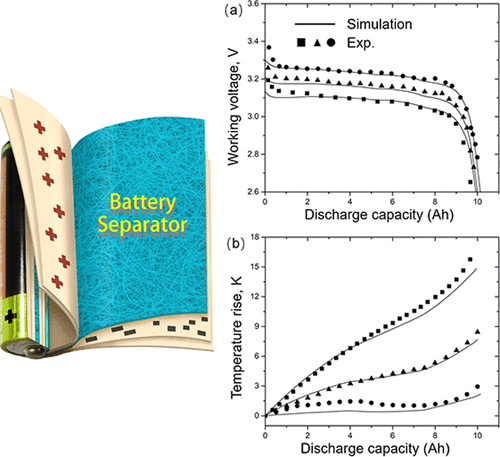当前位置:
X-MOL 学术
›
Energy Fuels
›
论文详情
Our official English website, www.x-mol.net, welcomes your
feedback! (Note: you will need to create a separate account there.)
Effects of a Separator on the Electrochemical and Thermal Performances of Lithium-Ion Batteries: A Numerical Study
Energy & Fuels ( IF 5.2 ) Pub Date : 2020-09-23 , DOI: 10.1021/acs.energyfuels.0c02609 Yifu Li 1 , Zhongchao Tan 1, 2
Energy & Fuels ( IF 5.2 ) Pub Date : 2020-09-23 , DOI: 10.1021/acs.energyfuels.0c02609 Yifu Li 1 , Zhongchao Tan 1, 2
Affiliation

|
Battery separator is a crucial component of a lithium-ion battery (LIB); it affects the battery performance. However, the effects of the separator on commercial cylindrical LIBs have not been well studied using computational models. This paper presents a numerical study on the effects of separator design on the LIB performance. We developed a two-dimensional electrochemical-thermal coupled model for a 38120-type LiFePO4 LIB. Model results showed that separator thickness strongly impacted battery energy density: the battery energy density dropped from 148.8 to 110.6 W h/kg, while the separator thickness increased from 5 to 100 μm. In addition, the mass transfer resistance of the separator increased with decreasing separator porosity, resulting in increased electrolyte concentration gradient. However, the correlation between separator porosity and electrolyte concentration gradient indicated that a separator porosity of 80% or greater contributed little to the resistance to mass transfer. Furthermore, the battery temperature rise and temperature difference dropped when both the separator thermal conductivity and heat capacity increased to 1 W m–1 K–1 and 3500 J kg–1 K–1, respectively.
中文翻译:

隔板对锂离子电池电化学和热性能的影响:数值研究
电池隔板是锂离子电池(LIB)的重要组成部分。它会影响电池性能。但是,使用计算模型尚未很好地研究隔板对商用圆柱形LIB的影响。本文对隔板设计对LIB性能的影响进行了数值研究。我们为38120型LiFePO 4开发了二维电化学热耦合模型LIB。模型结果表明,隔板厚度严重影响电池能量密度:电池能量密度从148.8 W / kg下降至110.6 W h / kg,而隔板厚度从5μm增加至100μm。另外,隔板的传质阻力随着隔板孔隙率的降低而增加,导致电解质浓度梯度增大。然而,隔板孔隙率与电解质浓度梯度之间的相关性表明80%或更高的隔板孔隙率对传质的阻力几乎没有贡献。此外,当隔板的导热系数和热容量分别增加到1 W m –1 K –1和3500 J kg –1 K时,电池温度升高且温度差减小。分别为–1。
更新日期:2020-11-19
中文翻译:

隔板对锂离子电池电化学和热性能的影响:数值研究
电池隔板是锂离子电池(LIB)的重要组成部分。它会影响电池性能。但是,使用计算模型尚未很好地研究隔板对商用圆柱形LIB的影响。本文对隔板设计对LIB性能的影响进行了数值研究。我们为38120型LiFePO 4开发了二维电化学热耦合模型LIB。模型结果表明,隔板厚度严重影响电池能量密度:电池能量密度从148.8 W / kg下降至110.6 W h / kg,而隔板厚度从5μm增加至100μm。另外,隔板的传质阻力随着隔板孔隙率的降低而增加,导致电解质浓度梯度增大。然而,隔板孔隙率与电解质浓度梯度之间的相关性表明80%或更高的隔板孔隙率对传质的阻力几乎没有贡献。此外,当隔板的导热系数和热容量分别增加到1 W m –1 K –1和3500 J kg –1 K时,电池温度升高且温度差减小。分别为–1。









































 京公网安备 11010802027423号
京公网安备 11010802027423号